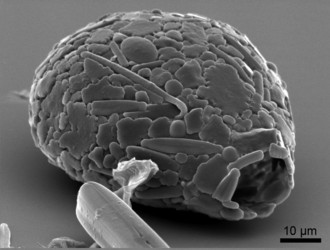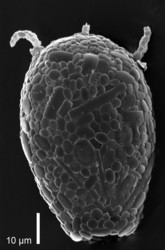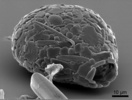Argynnia
Ralf Meisterfeld and Edward MitchellCharacteristics
Shell compressed, aperture surrounded by siliceous plates, giving it a rough outline. Shell greyish, composed of various euglyphid plates, mixed with diatom fragments and mineral particles, porous cement. The structure of the test is intermediate between Nebela and Difflugia. Nucleus: ovular. This genus was proposed by Jung (1942b) without type designation and validated by Vucetich (1974) including only three species from the southern hemisphere. Type species: Argynnia schwabei. Here Argynnia is used in a less restricted sense to allow for common and better known species with similar test structure, such as Argynnia dentistoma (Penard, 1890) (Synonym: N. dentistoma). Used in this broader sense Argynnia has about fifteen species.
Discussion of Phylogenetic Relationships
In an analysis of the SSU rRNA gene of several species of the family Hyalospheniidae, where Argynnia has traditionally been placed, Lara et al. (2008) could show that Argynnia dentistoma is not directly related to the "core Nebela". Until other species and genes have been studied with molecular methods the position of the genus remains uncertain.
Ecology
Habitat: A. dentistoma is common in mosses like Sphagnum or in acid humus, other species live in freshwater sediments.
References
Deflandre, G. 1936. Etude monographique sur le genre Nebela Leidy (Rhizopoda - Testacea). Ann. Protistol., 5:201-286.
Lara, E.; Heger, T.J.; Ekelund, F.; Lamentowicz, M. & Mitchell, E.A.D. 2008, Ribosomal RNA Genes Challenge the Monophyly of the Hyalospheniidae (Amoebozoa: Arcellinida). Protist, 159: 165 176.
Ogden, C. G. & Hedley, R. H. 1980. An Atlas of Freshwater Testate Amoebae. Oxford University Press, Oxford.
Title Illustrations

| Scientific Name | Argynnia dentistoma |
|---|---|
| Specimen Condition | Dead Specimen |
| Identified By | Ralf Meisterfeld |
| Copyright |
©
Ralf Meisterfeld

|
| Scientific Name | Argynnia caudata |
|---|---|
| Location | Eungella N.P., Queensland, Australia |
| Specimen Condition | Dead Specimen |
| Identified By | Ralf Meisterfeld |
| Copyright |
©
Ralf Meisterfeld

|
About This Page
This page is being developed as part of the Tree of Life Web Project Protist Diversity Workshop, co-sponsored by the Canadian Institute for Advanced Research (CIFAR) program in Integrated Microbial Biodiversity and the Tula Foundation.
Ralf Meisterfeld

Rheinisch-Westfälische Technische Hochschule Aachen, Germany
Edward Mitchell

University of Neuchâtel
Correspondence regarding this page should be directed to Ralf Meisterfeld at
meisterfeld@rwth-aachen.de
and Edward Mitchell at
edward.mitchell@unine.ch
Page copyright © 2008 Ralf Meisterfeld and Edward Mitchell
All Rights Reserved.
- First online 02 September 2008
- Content changed 02 September 2008
Citing this page:
Meisterfeld, Ralf and Edward Mitchell. 2008. Argynnia . Version 02 September 2008 (under construction). http://tolweb.org/Argynnia/124540/2008.09.02 in The Tree of Life Web Project, http://tolweb.org/










 Go to quick links
Go to quick search
Go to navigation for this section of the ToL site
Go to detailed links for the ToL site
Go to quick links
Go to quick search
Go to navigation for this section of the ToL site
Go to detailed links for the ToL site